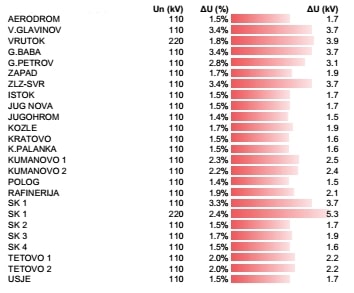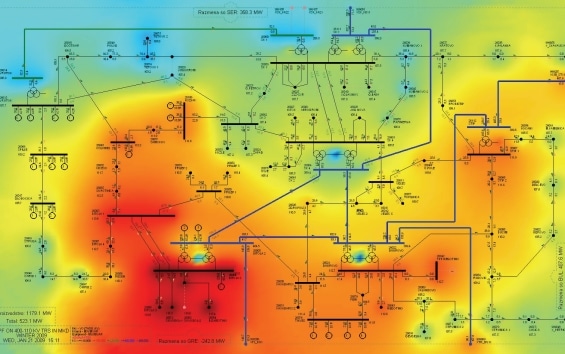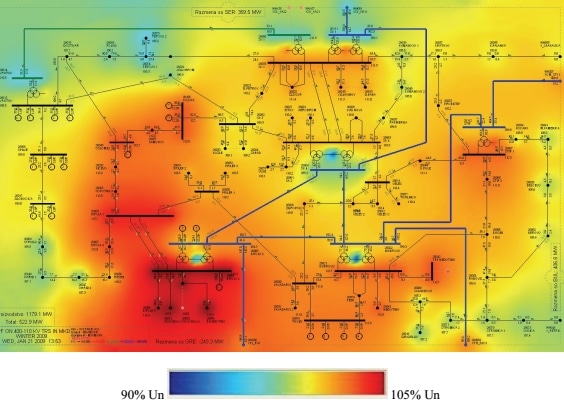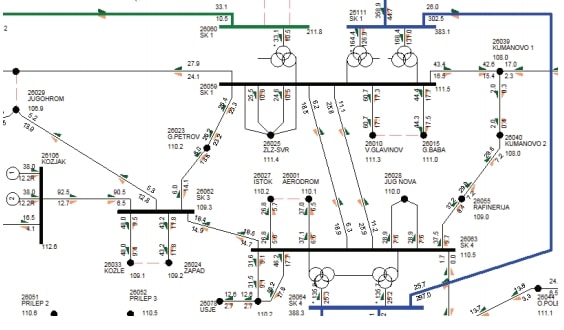In this article you will read about the technical and economic analysis for the optimal location of installation of 2 autotransformers with voltage ratio of 400/110 kV, which are equipped with automatic load regulation.
This article is a feedback from an electrical project. It was written and sent to us by your fellow electrical engineer Mile from Macedonia :) Let’s begin!
In the initial project, the transformation of the voltage from 400 kV to 110 kV shall be conducted with auto transformer with nominal power of 300/300/100 MVA and voltage ratio of 400/115/10,5 kV.
The transformer will have automatic regulation of the voltage ratio under load on the 400 kV level, in range -10×1.25%Un till +6×1.25%Un, or to be more specific, the regulation range from 87.5% (350 kV) till 107.5% (430 kV), with regulation step of 1.25% (5 kV).
The consumer profile of the two load centers that are fed through these transformer stations characterizes with lower voltage profile (the profile is lower than 110 kV) and increased losses of active power and energy. Therefore, the dilemma arises, where the autotransformers should be installed, so that we can increase the stability of the transmission power network.
Analysis of the autotransformers installation
We will look at several scenarios for this article. The first scenario case is when we do not have automatic regulation of the 400/110 kV transformers. Two main TS that we are going to examine are TS SKOPJE 5 and TS STIP. In TS STIP we have one 400/110 kV autotransformer already installed (it is the connection between Republic of Macedonia and Republic of Bulgaria).
All 400/110 kV are set to nominal ratio. Losses of active power in this scenario are ΔP = 34.11 MW. The voltages in the 110 kV network range between 107,2 kV till 108.8 kV. In case when in TS SKOPJE 5 one of the transformers is autotransformer, and the other one is not, we cannot activate automatic regulation. Activating the automatic regulations is possible in case when the transformers in TS Skopje 5 work on separate buses.
For our specific case, we will look at two separate variants. In the first variant, we suppose that the 400/110 kV transformer in TS Stip has automatic regulation. According the OPF (Optimal Power Flow) calculation, the voltage limits for that load center (city of Stip and the surrounding area) are set to 98% to 110% from the nominal voltage, from which we can conclude that we can receive optimal state of the consume center when the regulation is set to R = – 1. In this case the active power losses are ΔP = 34.06 MW.
In the second variant, we assume that the transformers in TS Skopje 5 have automatic regulation. During the OPF calculation, we stick to the fact that the voltage limitations of the system are stricter when compared to the first variant. The calculation shows that we can receive optimal state of the system when the regulation is set to R = -5×1.25%. In this case, the total active power losses are ΔP = 33.78 MW.
Autotransformers installation in the system
The change of the voltage ratio on the two transformers in TS Skopje 5, causes different flow of the reactive power in the system:
- Through the two transformers the reactive power flow increases to 2×130 MVAR,
- The reactive power flow through the transformers in TS Skopje 4 decreases for 2×40 MVAR,
- The flow to Kosovo decreases for about 30 MVAR
The biggest voltage rise shows on the 110 kV buses in the Skopje region (please see table 1). It must be noted that the voltage increase on 110 kV level, results in slight voltage decrease on 400 kV level. As additional information, on picture 1 the spectral analysis of the voltage profile before and after the activation of automatic regulation.

Table 1. 110 kV nodes with the biggest changes after automatic regulation activation in TS Skopje 5

Picture 2. (a) Before automatic regulation

Picture 2. (b) After automatic regulation
The voltage profiles and the power flow through the system, for the second variant are presented on picture 2.

Picture 2. Voltage profiles and power flow for variant 2
Conclusion
As better solution, variant 2 was chosen. It was agreed that the new transformer will be installed in TS Skopje 5, and the transformer without automatic regulation will be installed in TS Stip.
Although the expenses for implementation of variant 2 were low, the techno economic analysis made specifically for this case, shows that the ROI is approximately 2 years, which is acceptable.
Thanks for reading my electrical project story,
Mile :)
What do you think of this electrical project story? Share your impressions below.
